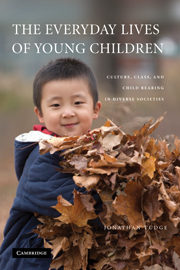Book contents
- Frontmatter
- Contents
- Preface
- Acknowledgments
- 1 Introduction and Stage Setting
- 2 The Daily Lives of Toddlers
- 3 Cultural–Ecological Theory and Its Implications for Research
- 4 Methods
- 5 Life in the Cities
- 6 Everyday Activities
- 7 Settings and Partners
- 8 Everyday Lives
- 9 The Cultural Ecology of Young Children
- References
- Index
- Frontmatter
- Contents
- Preface
- Acknowledgments
- 1 Introduction and Stage Setting
- 2 The Daily Lives of Toddlers
- 3 Cultural–Ecological Theory and Its Implications for Research
- 4 Methods
- 5 Life in the Cities
- 6 Everyday Activities
- 7 Settings and Partners
- 8 Everyday Lives
- 9 The Cultural Ecology of Young Children
- References
- Index
Summary
There must be a systole and diastole in all inquiry, … a man's mind must be continually expanding and shrinking between the whole human horizon and the horizon of a [magnifying]-glass.
(George Eliot, Middlemarch, 1872/1988, p. 524).In the previous chapter, I talked about the theoretical foundation for the research that is the focus for this book, explaining how it fits within the contextualist paradigm. In this chapter, I want to draw the connections between theory and method and describe the method that we use to gather our data. When people say that something or other is “fine in theory,” they typically mean that whatever it is will not work well in practice. In other words, sometimes people make an implicit distinction between theory and practice. What I want to do is make the opposite argument – namely, that what we do in practice is to a very large extent determined by our theory, if by “theory” we mean a way of making sense of the world, either implicitly or explicitly. In research this has to be the case – there needs to be a clear and firm connection between theory and method, as Vygotsky specified more than three quarters of a century ago: “Every basically new approach to scientific problems leads inevitably to new methods and ways of research” (Vygotsky, 1931/1997, p. 27).
- Type
- Chapter
- Information
- The Everyday Lives of Young ChildrenCulture, Class, and Child Rearing in Diverse Societies, pp. 88 - 109Publisher: Cambridge University PressPrint publication year: 2008

